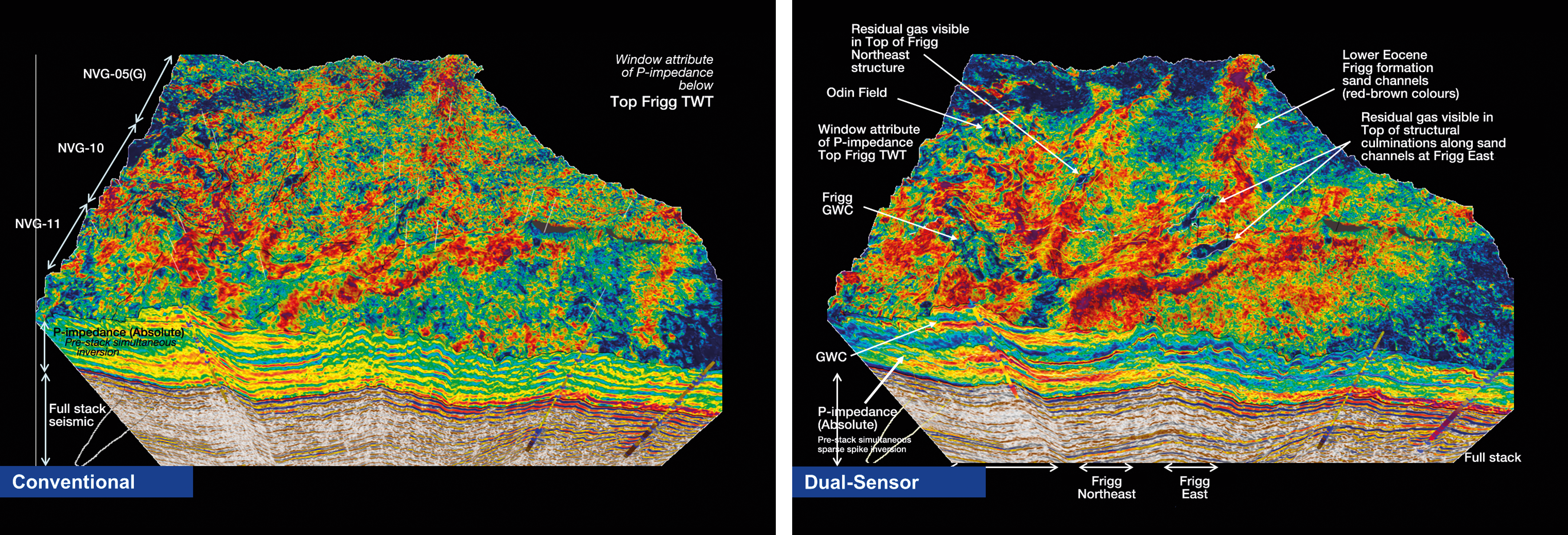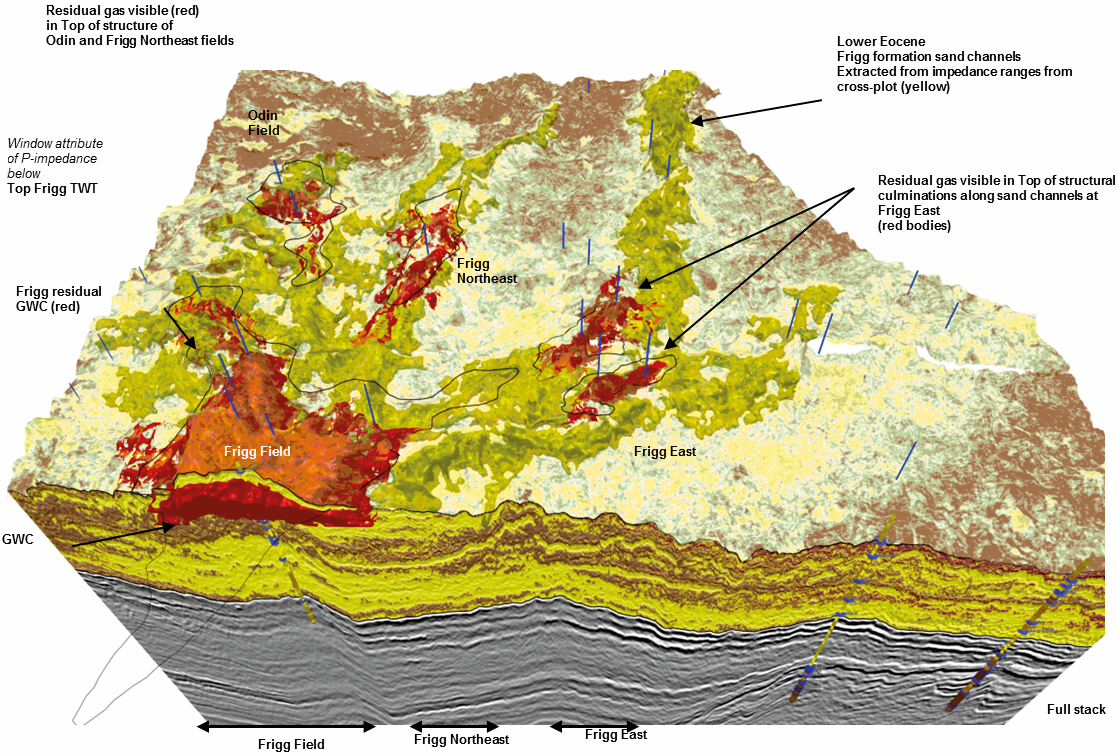To see the full seismic lines please download our PDF for the print issue available through this link: GEO ExPro Vol. 10 No. 2
Extracting more than mere frequencies
Recorded broadband data can have a huge impact on the reliable prediction of reservoir properties.
The most obvious benefits of broadband techniques relate to the increase in resolution on offer from the wider bandwidth, in addition to improved penetration due to signals richer in lower frequencies. The arguments for broadband are so compelling that there is good reason to believe that all new acquisition will be broadband before too long. The image of the fold-out area from the North Viking Graben on the previous pages illustrates the improved resolution available from the GeoStreamer dataset. Can you work without it? That’s ultimately the question that every explorer should ask him/herself. This type of seismic also amply demonstrates the improvement in interpretability – but there is value beyond merely improved resolution.

What is perhaps less well known and less publicized are applications in addition to pure imaging, where recorded broadband data has a huge impact on the reliable prediction of reservoir properties. The case study presented in this article highlights these benefits.
Deriving physical rock properties from seismic data offers great value to geoscientists. After all, it is rocks that we are drilling, not acoustic signals. Seismic inversion in combination with rock physics analysis is the most common workflow to derive rock or elastic properties from seismic data. A fundamental bias of all inversion methods is that a particular seismic dataset can lead to a number of alternative inversion results. With narrow band seismic data there is a lack of information on the high side and low side of the amplitude spectrum, so the geoscientists tend to constrain the number of possible solutions to reach the most reliable one. Normally, they do this by incorporating a background trend model based on known or ‘a priori’ information, usually nearby well data or other geological values. As a consequence, the uncertainty of the results away from these constraints, i.e. away from well control, increases significantly. Using broadband seismic data, with its greater frequency content, substantially reduces the amount and potential bias of ‘a priori’ data input – we can rely more on the 3D information content from seismic data away from well control. Recorded broadband data makes the inversion or any quantitative interpretation solution less dependent on what we already believe, and increases its usefulness in areas where a priori information may be scarce or uncertain. In other words it is a more data-driven inversion.
This case study from the North Sea area demonstrates how the use of broadband seismic fundamentally helps delineation of targets in the first place, and more importantly describes the internal structure of reservoirs and quantifies key reservoir properties, that in turn increases the probability of discriminating lithology and fluid facies.

Stretching ambitions
GeoStreamer acquisition and processing was recently performed over a 3D area in the North Viking Graben in the vicinity of the Heimdal and Frigg fields. Based on the results of the seismic processing, a complete reservoir characterization or quantitative interpretation project was carried out over the Frigg area (more than 1,000km2).
The Frigg field comprises a clastic reservoir of early Eocene age deposited in a deep marine environment and exhibits characteristic prograding submarine fan geometries on the seismic. The gas was discovered at a depth of around 2,000m and a clear flat
-spot signature is evident on the seismic. Production ceased and decommissioning of the field started in 2004, however residual gas is still present which can be analyzed and mapped on this seismic dataset.
On this dataset a full quantitative interpretation has been performed including wavelet extraction, low frequency model generation and pre-stack simultaneous inversion. The figure below illustrates the inversion results by comparing the acoustic impedance from the conventional and the recently acquired and processed dual-sensor seismic or ‘recorded broadband’. The contrasts between the results for the two co-located datasets eloquently summarize the previously described benefits of broadband seismic in terms of interpretability improvement and better delineation of the geological feature.
The main results of the comparison between the conventional and broadband seismic after pre-stack inversion are:
- Interpretability improvement: by being able to delineate the various stratigraphic units, for instance the prograding fore sets are better delineated on the broadband seismic data;
- Better delineation of the main geological features by separating the sands and shales responses with the inversion results. More low frequencies and better signal-to-noise improve the stability and resolution of the inversion results.
The improvement in results from dual-sensor pre-stack analysis gave encouragement that a better understanding of the lithology and fluid distribution in this dataset could be achieved by lithology-fluid classification. Elastic attributes have been classified based on a rock physics analysis performed for the area. The lithology fluid classification highlights all the main geological features and field architecture and differentiates channel sands, hydrocarbon sands, and the shale layers forming the reservoir seal. By overlaying the various field outlines on the 3D lithology fluid classification, the residual gas in the Frigg, Frigg East, Odin and other hydrocarbon accumulations can be seen clearly, located on the structural culminations of discrete localized channel fairways.

Improving accuracy
This is one of many recent case studies of recorded broadband seismic, highlighting that the extended seismic bandwidth of over an octave on both the low and high side noticeably improves the accuracy in the extracted elastic properties away from well control. The greater reliability of inversion results from dual-sensor seismic, with less reliance on local well bias, plays an important role in the evaluation and de-risking of prospects and optimizing well placement, through accurate lithology and fluid prediction.
Broadband seismic without receiver and source ghosts opens even more the possibility of interpreting and analyzing the true earth response with significantly less filtering and interference effects. The potential benefit of broadband seismic is therefore across the asset life from the exploration stage to production optimiz ation and resource esti m a tion with better constrained uncertainty.
We are just at the begin ning of realizing the full potential of such data and many more examples will be revealed shortly, demonstrating the power of such recorded and measured broad band seismic. Watch this space…
Acknowledgements
We would like to sincerely thank all our colleagues in PGS for all the fruitful discussions during the last few years and also PGS for permission to publish this work and the many contributors within the PGS organization.




